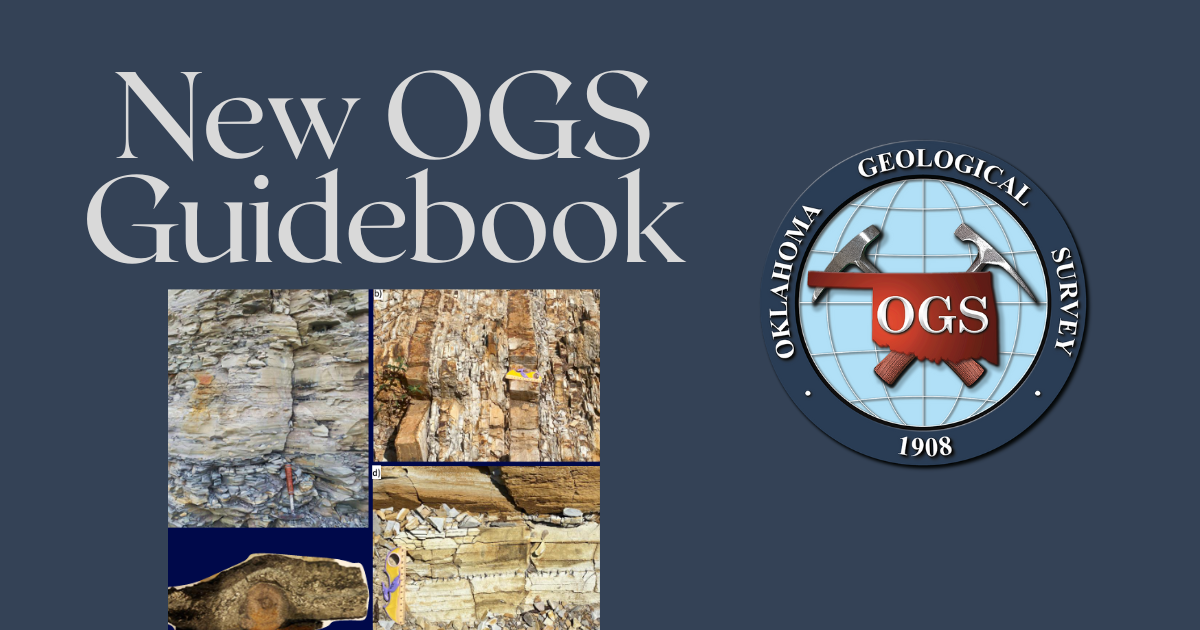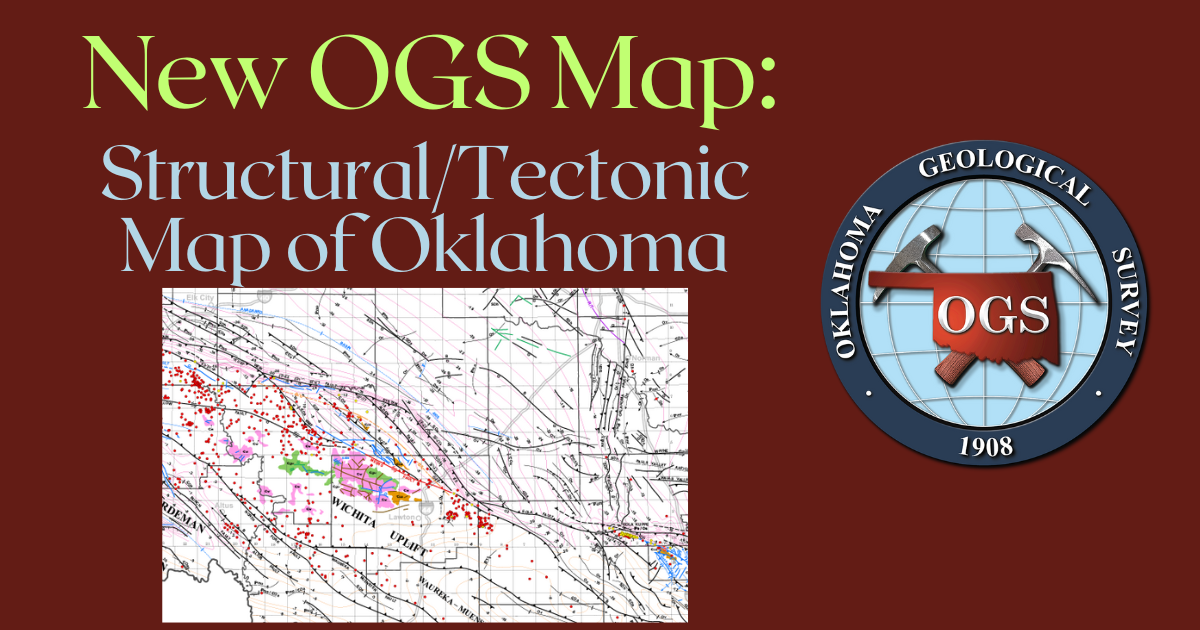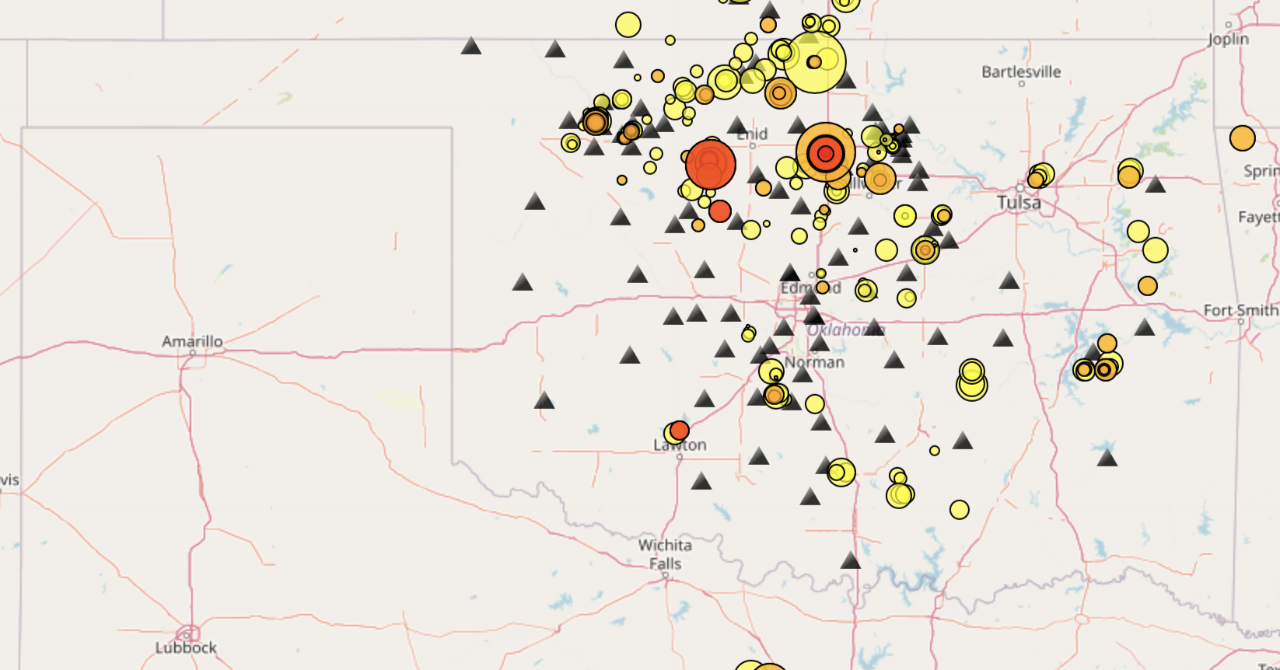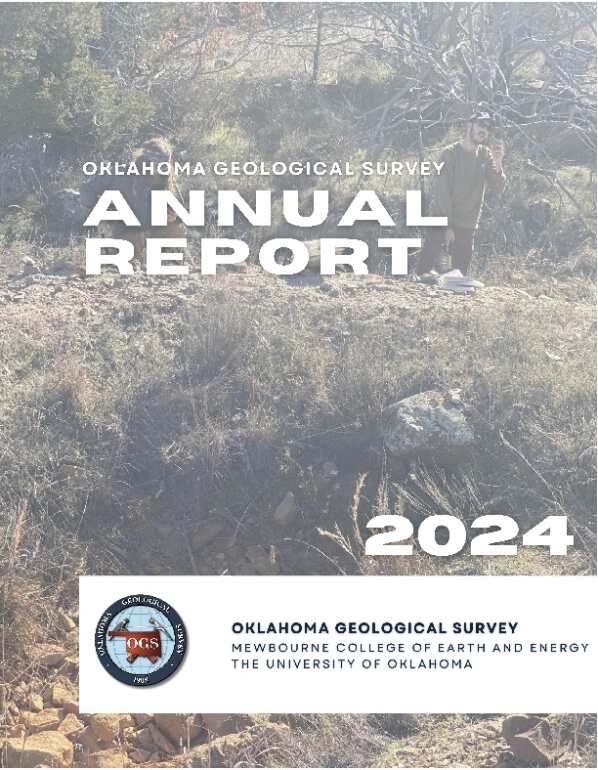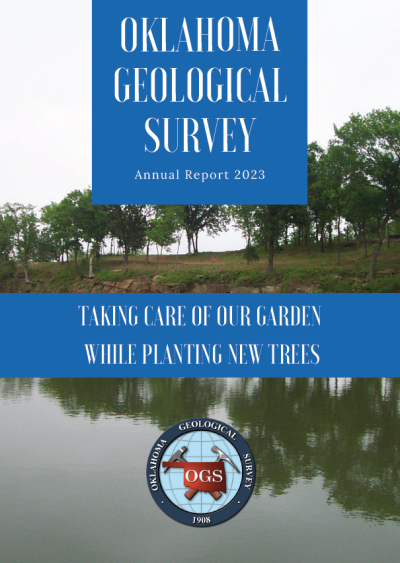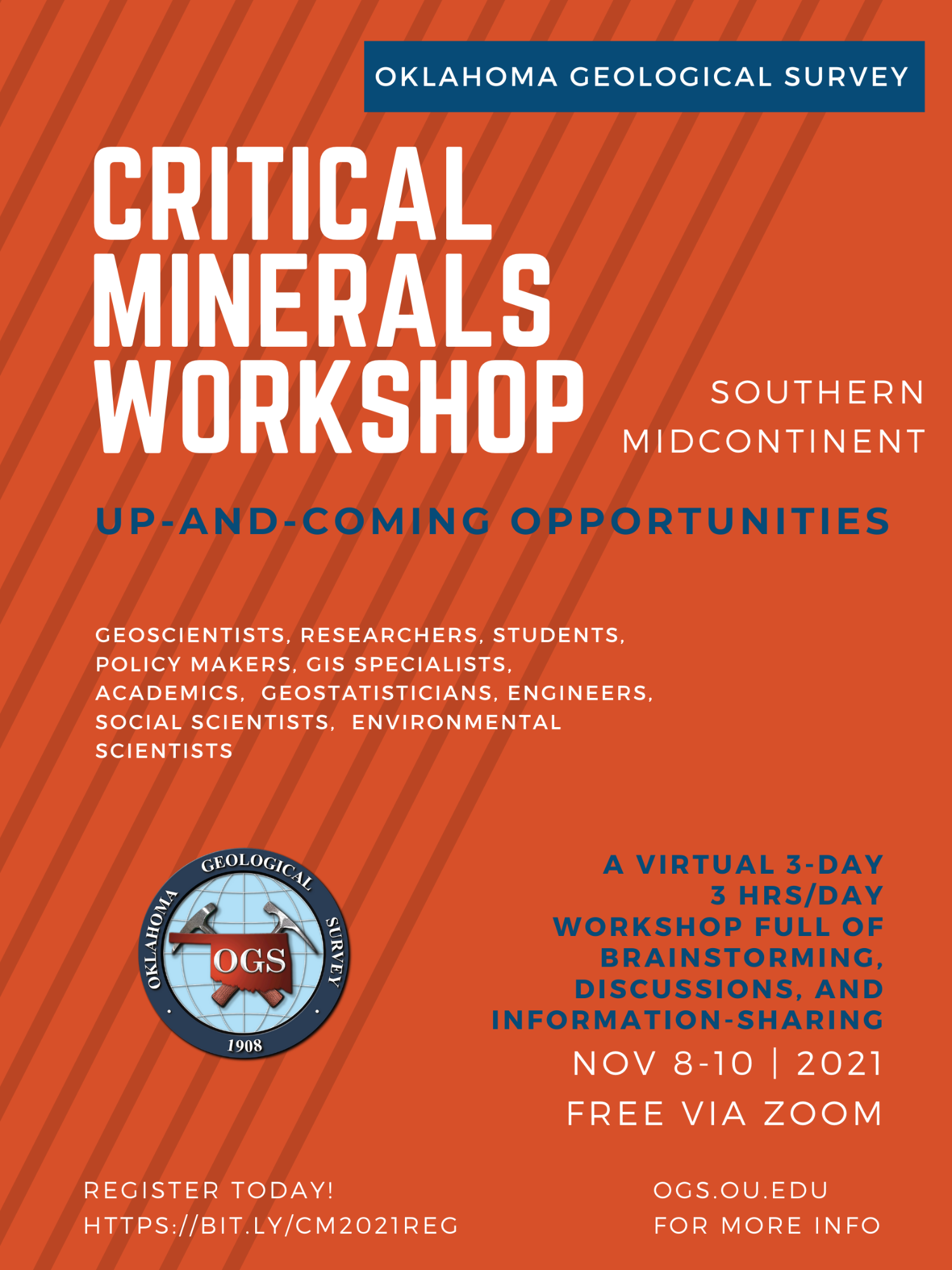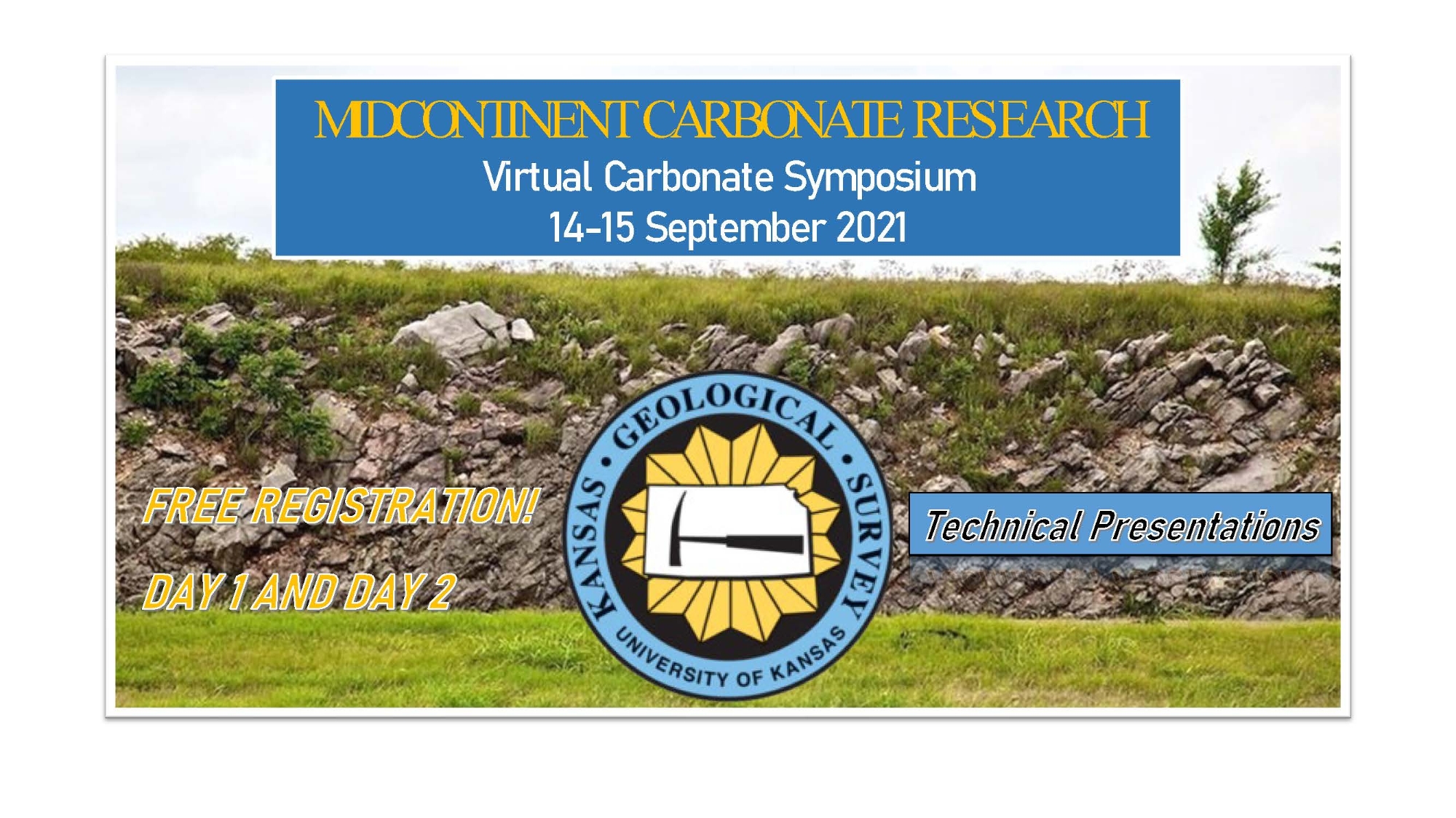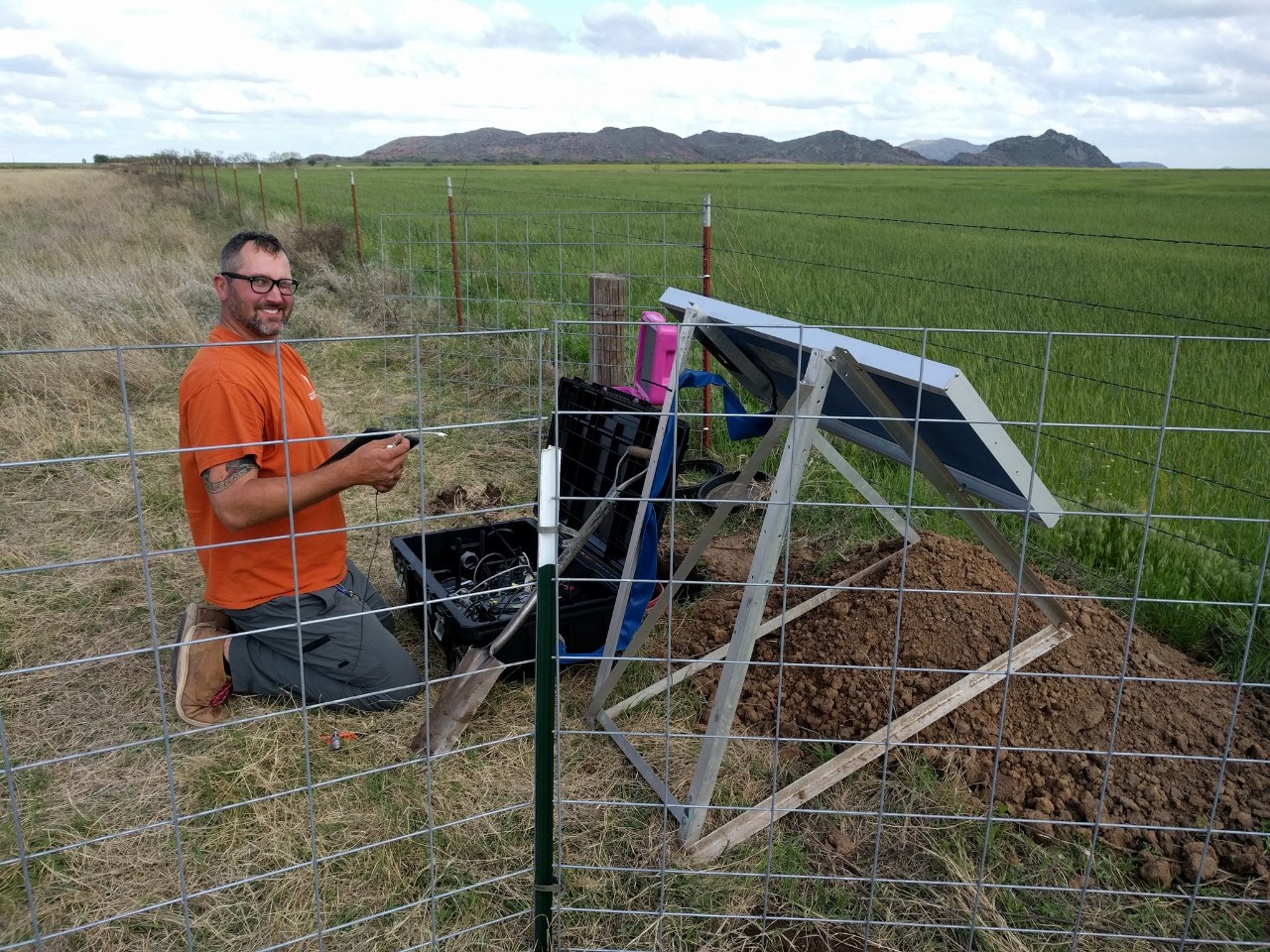Quicklinks
Latest OGS News
OGS Statement on May 23, 2025, earthquake near Pawnee
Updated 4:27 PM May 23, 2025
At 3:32 PM, local time, on May 23, 2025, a Magnitude 3.2 earthquake occurred northwest of Pawnee, OK, with reports of shaking in the immediate area north of Stillwater, OK. The M3.2 earthquake was not preceded by apparent activity in the last month, though a M2.2 earthquake was recorded on May 23, 2025. The earthquake occurred adjacent to a mapped fault that produced a Mw5.8 on September 3, 2016. There remains a high likelihood of aftershocks for the next several days. Whereas most aftershocks are smaller than the mainshock, a very small fraction of aftershocks result in a larger earthquake than the main event. As a previously active fault, the seismic hazard remains high in the area. We will continue to monitor the seismicity and provide assistance to the Oklahoma Corporation Commission (OCC), other state agencies, and the public. The earthquake catalog is updated in real-time (https://ogsweb.ou.edu/quake_viewer/) and the state catalog is redundantly reported to USGS; USGS events within the state are derived directly from OGS earthquake locations and magnitudes since May 2019.
The Oklahoma Geological Survey (OGS) is a state agency and a research organization of the University of Oklahoma. OGS monitors seismicity throughout the state; an effort that began with the Leonard Geophysical Observatory starting in the 1970s and continues today in Norman. Today, the seismic network encompasses 100+ seismometers that deliver real-time data to the central data hub in Norman. Analysts in Norman process the seismic data and deliver updated earthquake locations, magnitudes, and other scientific data products that are freely-available and shared through the OGS website (http://ogs.ou.edu/) and through collaborative partners at the United States Geological Survey.
Contact:
Dr. Jake Walter, State Seismologist
Oklahoma Geological Survey
405-325-8497
OGS Annual Report - 2024
OGS Annual Report - 2023
OGS Statement on February 2, 2024 M5.1 Prague earthquake
There was a M5.1 event at 11:24 PM local time last night located approximately 8 km to the northwest of Prague, OK. This event has been followed by several aftershocks in the intervening hours. There were reports of strong shaking in the immediate area and it was widely reported as being felt statewide, including the Oklahoma City and Tulsa metro areas. We should expect several strong aftershocks in the coming weeks that may be widely felt. Whereas most aftershocks are smaller than the mainshock, a very small fraction of aftershocks result in a larger earthquake than the main event. The seismic hazard remains high in the area. Citizens should secure valuables that might shake during possible strong aftershocks and practice Drop, Cover, and Hold On in the event of damaging events. The event occurred in nearly the same area as the 2011 M5.7 Prague earthquake that has been identified as having been induced by wastewater disposal activities. We will continue to monitor the seismicity and provide assistance to the Oklahoma Corporation Commission (OCC), other state agencies, and the public.
The earthquake catalog is updated in real-time (https://wichita.ogs.ou.edu/staff/earthquake/events.html) and the state catalog is redundantly reported to USGS; USGS events within the state are derived directly from OGS earthquake locations and magnitudes since May 2019.
The Oklahoma Geological Survey (OGS) is a state agency and a research organization of the University of Oklahoma. OGS monitors seismicity throughout the state; an effort that began with the Leonard Geophysical Observatory starting in the 1970s and continues today in Norman. Today, the seismic network encompasses 90+ seismometers that deliver real-time data to the central data hub in Norman. Analysts in Norman process the seismic data and deliver updated earthquake locations, magnitudes, and other scientific data products that are freely-available and shared through the OGS website (http://ogs.ou.edu/) and through collaborative partners.
Contact:
Dr. Jake Walter, State Seismologist
Oklahoma Geological Survey
405-325-8497
OGS Statement on January 12/13, 2024 earthquakes near Arcadia, OK
There was a M4.3 event at 9:46 PM local time yesterday evening, followed by a M4.1 this morning, about 5:36 AM on January 13, 2024. There were reports of strong shaking in the immediate area and across Oklahoma City. The M4.4 yesterday evening was preceded by a M3.2 foreshock almost 10 minutes prior to the M4.4. In addition, there has been activity along this fault in the last month starting on December 29, with 5 events between M1.0-1.6 between December 29 and January 6. The seismicity from the last decade indicates there were 3 M4.0 or greater events in 2015 and 2017, corresponding to a time period when wastewater disposal volumes were higher. Whereas most aftershocks are smaller than the mainshock, a very small fraction of aftershocks result in a larger earthquake than the main event. The seismic hazard remains high in the area. Citizens should secure valuables that might shake during possible strong aftershocks and practice Drop, Cover, and Hold On in the event of damaging events. We will continue to monitor the seismicity and provide assistance to the Oklahoma Corporation Commission (OCC), other state agencies, and the public.
The earthquake catalog is updated in real-time (https://wichita.ogs.ou.edu/staff/earthquake/events.html) and the state catalog is redundantly reported to USGS; USGS events within the state are derived directly from OGS earthquake locations and magnitudes since May 2019.
The Oklahoma Geological Survey (OGS) is a state agency and a research organization of the University of Oklahoma. OGS monitors seismicity throughout the state; an effort that began with the Leonard Geophysical Observatory starting in the 1970s and continues today in Norman. Today, the seismic network encompasses 90+ seismometers that deliver real-time data to the central data hub in Norman. Analysts in Norman process the seismic data and deliver updated earthquake locations, magnitudes, and other scientific data products that are freely-available and shared through the OGS website (http://ogs.ou.edu/) and through collaborative partners.
Contact:
Dr. Jake Walter, State Seismologist
Oklahoma Geological Survey
405-325-8497
Registration is now open
Geology Field Trip to the Wichita Mountains
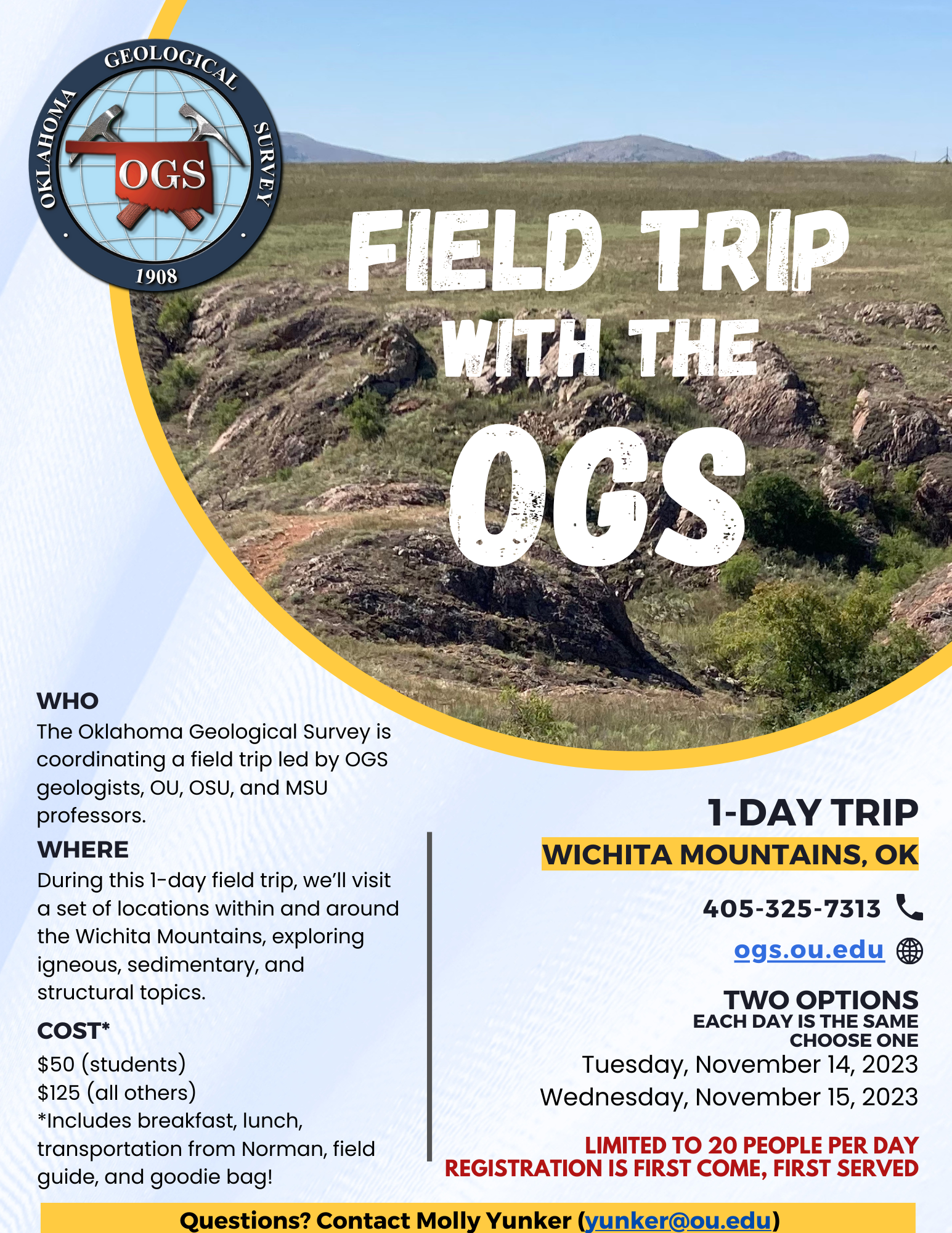
OGS Statement on April 6, 2023 earthquake near Chandler, OK
At nearly 4:00 AM local time, on April 6, 2023, a M4.0 earthquake occurred northwest of Chandler, OK. There were reports of strong shaking in the immediate area and across Tulsa, Oklahoma City, Norman, and Wichita. The M4.0 earthquake was preceded by 7 events beginning Tuesday evening and include activity in the last several years, with most previous earthquakes too small to be felt by people. At least 6 aftershocks have been recorded as of mid-day Thursday and there remains a high likelihood of more aftershocks for the next several days. Whereas most aftershocks are smaller than the mainshock, a very small fraction of aftershocks result in a larger earthquake than the main event. The seismic hazard remains high in the area. We will continue to monitor the seismicity and provide assistance to the Oklahoma Corporation Commission (OCC), other state agencies, and the public.
The earthquake catalog is updated in real-time (https://wichita.ogs.ou.edu/staff/earthquake/events.html) and the state catalog is redundantly reported to USGS; USGS events within the state are derived directly from OGS earthquake locations and magnitudes since May 2019.
The Oklahoma Geological Survey (OGS) is a state agency and a research organization of the University of Oklahoma. OGS monitors seismicity throughout the state; an effort that began with the Leonard Geophysical Observatory starting in the 1970s and continues today in Norman. Today, the seismic network encompasses 100+ seismometers that deliver real-time data to the central data hub in Norman. Analysts in Norman process the seismic data and deliver updated earthquake locations, magnitudes, and other scientific data products that are freely-available and shared through the OGS website (http://ogs.ou.edu/) and through collaborative partners.
OGS Workshop: Oklahoma and the Energy Transition
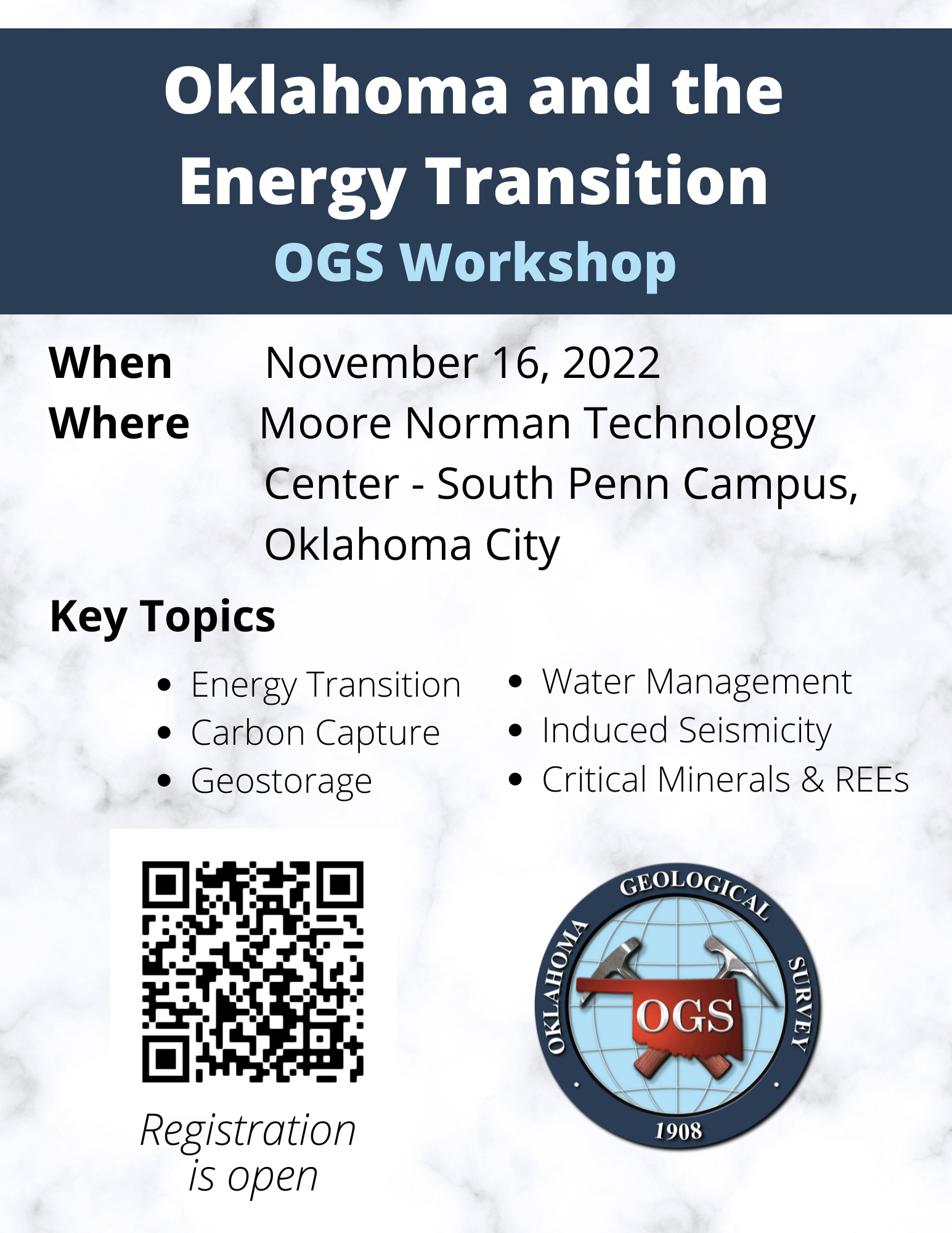
Behind-the-Scenes Visit to the Sam Noble Museum
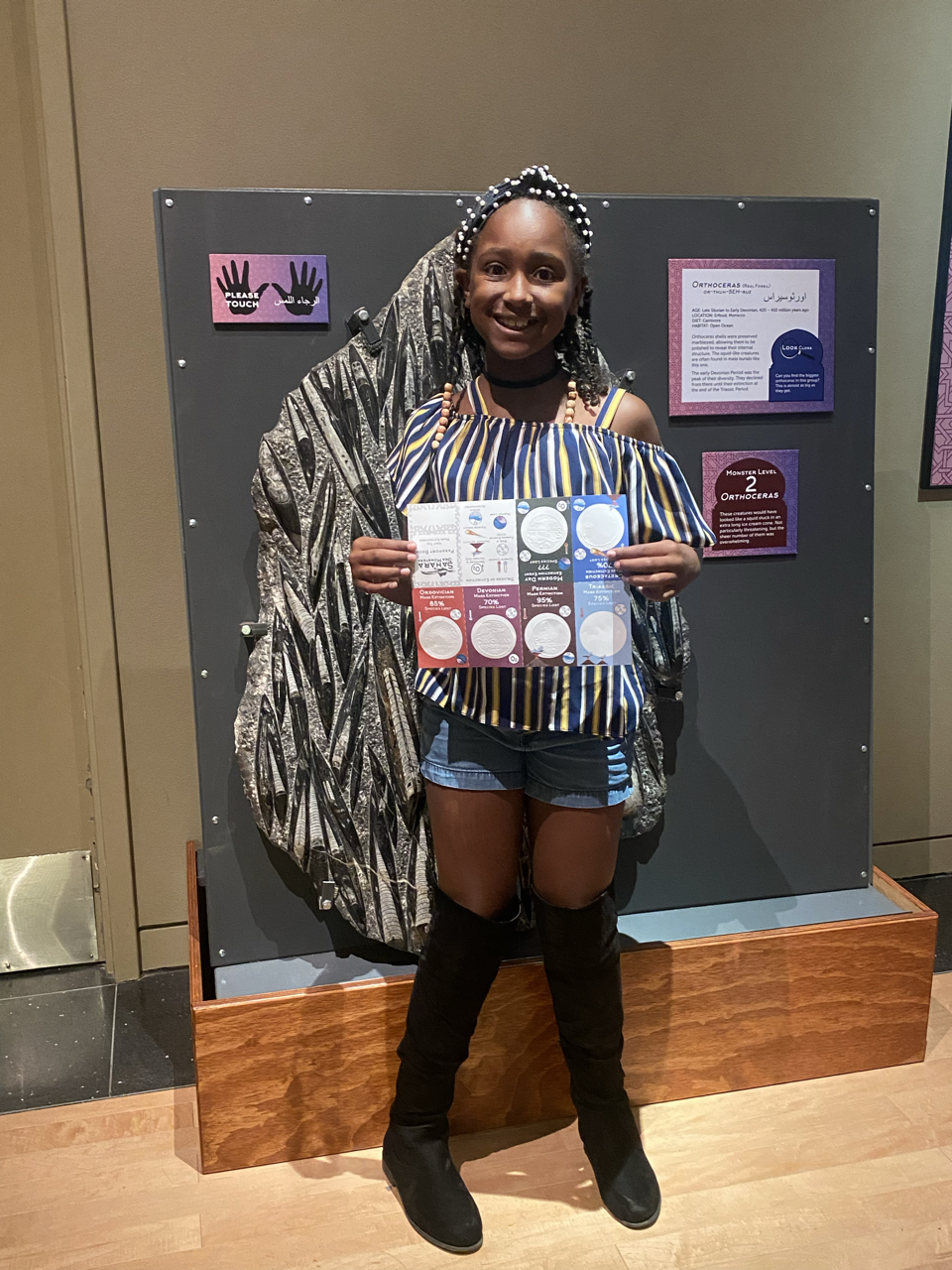
Girl Scout Aleigha O. poses with some orthoceras fossils and her completed Mass Extinction Passport Book!
The OGS, in collaboration with the Oklahoma Geological Foundation and the Sam Noble Museum of Natural History took the Girl Scouts of Western Oklahoma Geology Club (with funding from Devon Energy) on a behind-the-scenes tour of the Vertebrate Paleontology department, and the brand new Sahara Sea Monsters exhibit which is about to open to the public. This was an amazing way to explore their interests in STEM careers with wonderful role models, Tia Ruppert and Dr. Jac Lungmus!
Sixty-six enthuiastic visitors enjoyed this experience, and we look forward to future collaborations between the OGS, OGF, SNMNH, and the Girl Scouts!
Be prepared for an earthquake!
OGS Statement on January 31, 2022 earthquake near Medford
Updated 12:30 PM January 31, 2022
Around 11:10 AM, local time, on January 31, 2022, a M4.5 earthquake occurred northwest of Medford, OK. There were reports of strong shaking in the immediate area and across Tulsa, Oklahoma City, Norman, and Wichita. The M4.5 earthquake was preceded by activity in the last several years, with most previous earthquakes too small to be felt by people. At least 2 aftershocks have been recorded in the first few hours after the event and there remains a high likelihood of more aftershocks for the next several days. Whereas most aftershocks are smaller than the mainshock, a very small fraction of aftershocks result in a larger earthquake than the main event. The seismic hazard remains high in the area. We will continue to monitor the seismicity and provide assistance to the Oklahoma Corporation Commission (OCC), other state agencies, and the public. The earthquake catalog is updated in real-time (https://wichita.ogs.ou.edu/staff/earthquake/events.html) and the state catalog is redundantly reported to USGS; USGS events within the state are derived directly from OGS earthquake locations and magnitudes since May 2019.
The Oklahoma Geological Survey (OGS) is a state agency and a research organization of the University of Oklahoma. OGS monitors seismicity throughout the state; an effort that began with the Leonard Geophysical Observatory starting in the 1970s and continues today in Norman. Today, the seismic network encompasses 100+ seismometers that deliver real-time data to the central data hub in Norman. Analysts in Norman process the seismic data and deliver updated earthquake locations, magnitudes, and other scientific data products that are freely-available and shared through the OGS website (http://ogs.ou.edu/) and through collaborative partners.
Contact:
Dr. Jake Walter, State Seismologist
Oklahoma Geological Survey
405-325-8497
We are hiring! Administrative Technician - OPIC
Job Description -
The Administrative Technician of the Oklahoma Petroleum Information Center (OPIC) provides administrative, clerical, and technical support. This position coordinates shipping and receiving functions for OPIC sales. It also manages the inventory, sends invoices, and processes deposits.
Click here to view the job ad
Critical Minerals Workshop - Workshop has ended
2021 Kansas Geological Survey Midcontinent Carbonate Research Virtual Symposium
Carbonate sedimentary rocks of the Midcontinent region of the United States have been studied for many decades and contributed to the development of fundamental concepts in sedimentology and stratigraphy. In addition to hosting active and mature hydrocarbon reservoirs, the carbonate intervals have more recently been targeted for CO2 sequestration, and outcrops have served as analogs for emerging carbonate plays.
The organizing committee at the Kansas Geological Survey invites you to attend a virtual KGS Carbonate Symposium that will be held 14-15 September 2021. The symposium program will feature multidisciplinary presentations from leading scientists and industry experts from across the Midcontinent region. The goal is to have an interactive session to share new research, learn best practices, recent developments, exchange ideas, and explore opportunities for future collaboration. A list of presentations and information on free registration can be found here.
Note that registration is limited and that there is a separate registration link for each day, so please make sure to register for both Day 1 and Day 2. Come join us and share your perspective for this exciting event!
For any questions regarding registration please contact: Blair Schneider (blair.schneider@ku.edu)
OGS Statement on February 5, 2021 earthquakes near Perry
Around 10:17 AM, local time, on February 5, 2021, a M3.5 and M3.7 earthquake occurred less than a minute apart from one another between the towns of Lucien, OK and Covington, OK. Subsequently, a M4.2 earthquake occurred around 11:49 AM, with reports of strong shaking in the immediate area and light shaking in Tulsa, Oklahoma City, Norman, and Wichita, KS. The M4.2 earthquake was preceded by activity in the last several years, with most previous earthquakes too small to be felt by people. At least 8 aftershocks have been recorded as of this update and there remains a high likelihood of more aftershocks for the next several days. Whereas most aftershocks are smaller than the mainshock, a very small fraction of aftershocks result in a larger earthquake than the main event. The seismic hazard remains high in the area. We will continue to monitor the seismicity and provide assistance to the Oklahoma Corporation Commission (OCC), other state agencies, and the public. The earthquake catalog is updated in real-time and the state catalog is redundantly reported to USGS; USGS events within the state are derived directly from OGS earthquake locations and magnitudes since May 2019.
The Oklahoma Geological Survey (OGS) is a state agency and a research organization of the University of Oklahoma. OGS monitors seismicity throughout the state; an effort that began with the Leonard Geophysical Observatory starting in the 1970s and continues today in Norman. Today, the seismic network encompasses 100+ seismometers that deliver real-time data to the central data hub in Norman. Analysts in Norman process the seismic data and deliver updated earthquake locations, magnitudes, and other scientific data products that are freely-available and shared through the OGS website and through collaborative partners.
Contact:
Dr. Jake Walter, State Seismologist
Oklahoma Geological Survey
405-325-8497
*NOW CLOSED* We are hiring! TWO open positions at the Oklahoma Geological Survey
Title: Geologist II
Position: Full-time
Relocation (if needed): negotiable up to $7k
Salary band: $65,000-$79,000
The Oklahoma Geological Survey (OGS) seeks two geologists to conduct research and service in one or more of the following areas: hydrogeology, stratigraphy, mineral resources, digital field mapping (inc. GIS), computational geosciences (inc. data structures, machine learning, numerical modeling). The qualified applicants will have a M.S. or Ph.D. (preferred) and 1-3 years of additional experience. OGS is increasingly focused on subsurface storage of alternative fuels and CO2, as well as existing strengths in petroleum geology, induced seismicity, groundwater resources, and regional geological projects. OGS serves the state by monitoring and studying geohazards, hosting an authoritative collection of data and samples, and providing educational resources to the public. As part of the University of Oklahoma, OGS geologists can mentor students in the Mewbourne College of Earth and Energy. OGS geologists support science efforts by seeking external funding, leading workshops, and publishing. OGS is an equal opportunity employer committed to employing a highly qualified staff that reflects the diversity of our state and our nation. More information about the OGS staff and activities can be found at https://www.ou.edu/ogs. The job opportunity announcement with application procedures may be viewed at: https://link.ou.edu/203255. Review of applications will begin on February 1, 2021. Please direct inquiries to Nicholas Hayman (ogs@ou.edu, place “Geologist II” in the subject line).
*VIRTUAL* Shale Resource Plays of Oklahoma workshop
The workshop has ended. You can visit the link below for access to video presentations and slides.
For details, visit: https://www.ou.edu/ogs/workshops/shaleplaysOK
For questions, please email Molly Yunker.
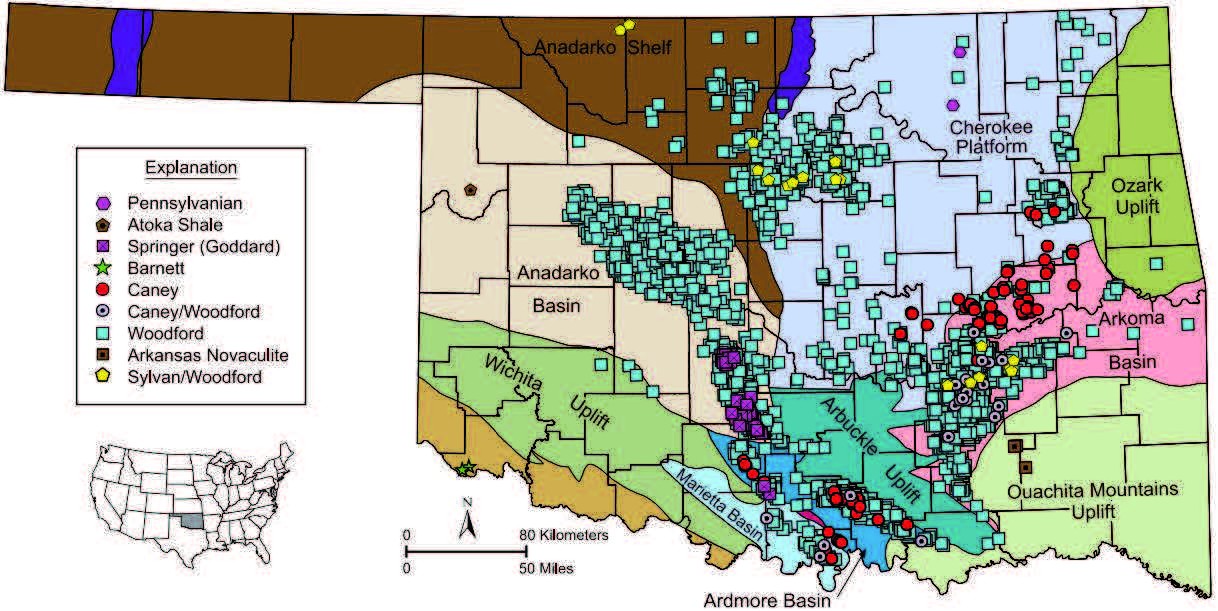
Oklahoma Geological Survey Announces New Director

Nicholas Hayman, an accomplished researcher whose area of expertise centers around marine geology and geophysics, tectonics, seismicity and the interdependence between engineering and geosciences, recently was named as director of the Oklahoma Geological Survey at the University of Oklahoma. Hayman comes from the Institute for Geophysics at the University of Texas and succeeds former director Jerry Boak, who retired in 2019.
Hayman hopes his new role will produce increased collaboration between the survey and public and private entities throughout Oklahoma.
“We’re going to chart new directions in geological and energy sciences,” said Hayman. “By developing external support and broader collaboration with researchers around the state, I want to continue the work on both understanding and mitigating induced seismicity in Oklahoma, while also broadening our scope to study the local effectiveness of new technologies in upcoming areas such as carbon capture and alternative energy resources. Most importantly, we will maintain the survey’s core mission of serving Oklahomans by providing an enhanced understanding of their environment.”
Hayman earned his doctorate at the University of Washington in 2003.
“We are so excited to have found someone so qualified to lead the Oklahoma Geological Survey,” said Mike Stice, dean of the Mewbourne College of Earth and Energy. “Nick Hayman is a proven leader and is already a well-known researcher. We look forward to his leadership as the survey continues to provide excellence in service to the university, the state and the public at large.”
OGS Seismic Technician, Isaac Woelfel has been Recognized with a Staff Advocate Award
Congratulations to Isaac Woelfel for being recognized as a Staff Advocate! This award is for faculty or staff members for significant accomplishment in support of College-wide initiatives or community service, as recommended by their peers or supervisors.
You can read about Isaac and other awardees on the MCEE Blog.
OGS Statement on June 20, 2020 earthquake near Perry
Updated 9:00am
At 10:15 PM, local time, on June 20, 2020 a Magnitude 4.2 earthquake occurred northwest of Perry, OK, with reports of strong shaking in the immediate area and light shaking in Tulsa, Oklahoma City, Norman, and Wichita. The M4.2 earthquake was preceded by activity in the last several months, with most previous earthquakes too small to be felt by people. Several aftershocks have been recorded over the last several days and there remains a high likelihood of more aftershocks for the next several days. Whereas most aftershocks are smaller than the mainshock, a very small fraction of aftershocks result in a larger earthquake than the main event. The seismic hazard remains high in the area. We will continue to monitor the seismicity and provide assistance to the Oklahoma Corporation Commission (OCC), other state agencies, and the public. The earthquake catalog is updated in real-time (https://ogsweb.ou.edu/quake_viewer/) and the state catalog is redundantly reported to USGS; USGS events within the state are derived directly from OGS earthquake locations and magnitudes since May 2019.
The Oklahoma Geological Survey (OGS) is a state agency and a research organization of the University of Oklahoma. OGS monitors seismicity throughout the state; an effort that began with the Leonard Geophysical Observatory starting in the 1970s and continues today in Norman. Today, the seismic network encompasses 100+ seismometers that deliver real-time data to the central data hub in Norman. Analysts in Norman process the seismic data and deliver updated earthquake locations, magnitudes, and other scientific data products that are freely-available and shared through the OGS website (http://ogs.ou.edu/) and through collaborative partners.
Contact:
Dr. Jake Walter, State Seismologist
Oklahoma Geological Survey
405-325-8497
jwalter@ou.edu
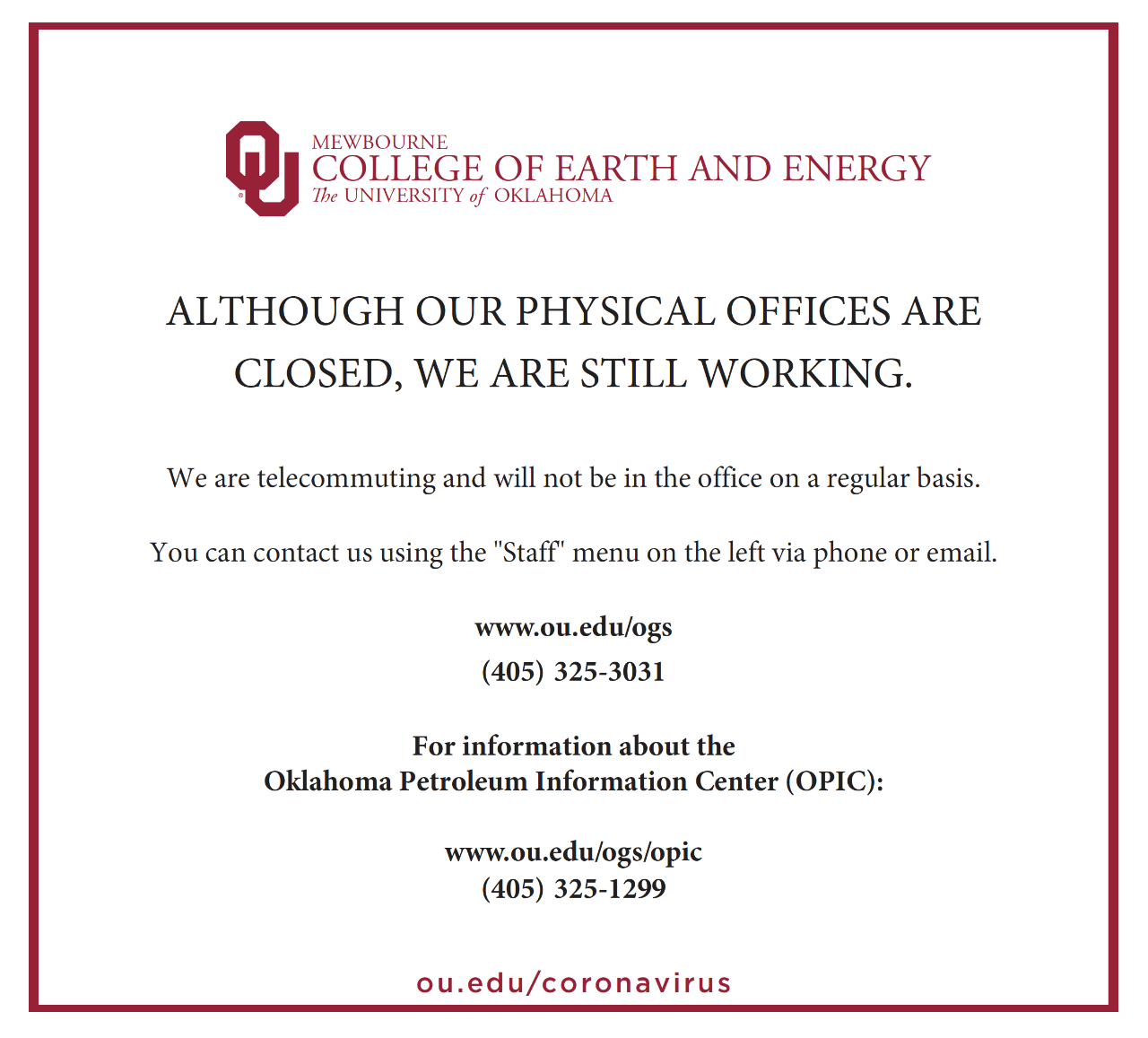
COVID-19 UPDATE - OGS OFFICES CLOSED
A message from the Associate Director
Dear Oklahoma Geological Survey Friends and Colleagues,
The situation surrounding the COVID-19 pandemic is unprecedented for all of us. To say things are a bit different in our world is certainly an understatement. Our hearts go out to all of you during these trying times. We at the OGS are acting appropriately to ensure the health and well-being of all our researchers and staff, and all those we serve daily. As a state agency we are committed to supporting the people of Oklahoma in any way we can. We are equally committed to supporting the University of Oklahoma community, and especially our family within the Mewbourne College of Earth and Energy.
To help prevent the spread of this virus, we have followed the guidance of University and State officials and have closed our offices to the general public for the foreseeable future. Our team members are now teleworking from home as needed. This also includes our core facility and data library at the Oklahoma Petroleum Information Center (OPIC), which is also closed to the public for the foreseeable future. Our scientists will do their best to assist you remotely if possible, and I ask that you email them with your questions or call and leave a message if a need arises. A response will follow as soon as possible. Contact information can be found on the Staff link on the left side of our homepage.
Note that we have also cancelled all outreach activities planned for the near future. Teachers and students can contact any of our geoscientists by submitting questions they may have.
Our OGS Seismic team continues to diligently monitor our seismic array for activity across Oklahoma and has coordinated their plans with State officials. There will be no interruption in this service.
We are monitoring the latest information along with our University and State leaders to determine if further operational changes should be made. As we move forward, we pledge to serve you as best we can. We’re all Oklahomans, and we will beat this thing.
Stay healthy and safe.
Best Regards,
David P. Brown
Associate Director
COVID-19 Update - OPIC
The Oklahoma Geological Survey – Oklahoma Petroleum Information Center (OPIC) will be closed to the general public effective March 13th through April 6th due to health and safety concerns over the spread of the COVID-19 virus. This is a preemptive measure to protect OPIC visitors and staff in compliance with the University of Oklahoma’s preventative measures amid this emerging public health situation. We apologize for any disruptions this may cause.
For more information please call (405) 325-1299 or visit ou.edu/ogs.
New Publication Focused on Oklahoma's Seismic Network
Jake Walter, Paul Ogwari, Andrew Thiel, Fernando Ferrer, and Isaac Woelfel published a paper describing the history and current status of the Oklahoma Geological Survey seismic network. The paper, entitled “The Oklahoma Geological Survey Statewide Seismic Network,” is part of a Special Issue on Regional Seismic Networks for the journal Seismological Research Letters. They describe the recent certification of the OGS regional network as part of the USGS reporting system and recent improvements to monitoring.
EOR Workshop held November 14-15, 2019
OGS hosted a workshop focused on Enhanced Oil Recovery (EOR) on November 14th, 2019 at Moore-Norman Technology Center - South Penn Campus. About 110 people attended the event. The following day, we hosted a half-day, optional Core Workshop for those who attended the Technical Program. The Core Workshop was held at OPIC (Oklahoma Petroleum Information Center) in Norman, OK on November 15, 2019 and a total of sixty people attended two half-day sessions. Thank you to all of our presenters, sponsors, and supporters!

Dr. Jake Walter gives a RISC Webinar - "The Past and Future Seismic Hazard in Oklahoma"
You can view the webinar at the following link:
http://www.beg.utexas.edu/files/risc/video/RISC%20Webinar_20191010_Jake%20Walter.mp4
Associate director radio interview
OGS Associate Director David P. Brown was interviewed October 18, 2019 on the Exploring Energy radio show on KECO. Topics include OPIC and the upcoming EOR workshop. Click below to hear an edited version of the show.
New Publication: Comparison of Aftershock Zones in OK and CA
OGS researchers find that aftershock zones in Oklahoma are much narrower than aftershock zones in California. The findings will help improve seismic hazard estimates within the region. The research was led by Zach Rosson, who was recently awarded an MS degree from the OU School of Geosciences. The paper and his graduate thesis were supervised by State Seismologist Jake Walter at the Oklahoma Geological Survey and Assistant Professor Xiaowei Chen at the OU School of Geosciences. The paper is publicly available for download (open access) at the following link:
https://agupubs.onlinelibrary.wiley.com/doi/abs/10.1029/2019GL083562
Rosson, Z., J. I. Walter, T. Goebel, and X. Chen (2019), Narrow spatial aftershock zones for induced earthquake sequences in Oklahoma Geophys. Res. Lett., https://doi.org/10.1029/2019GL083562.
OGS Scientists Receive Grant
Netra Regmi and Jacob Walter recently received a two-year research grant from FEMA via Oklahoma Department of Emergency Management (~$87,000, including 25% match from OU) to support research focused on mapping causes, mechanics and susceptibility of landslides in Ozarks and Ouachita Mountains of eastern Oklahoma and western Arkansas, and to organize a conference and field excursion for local emergency managers. Following is their recently published article:
Regmi, Netra R., and Jacob I. Walter. "Detailed mapping of shallow landslides in eastern Oklahoma and western Arkansas and potential triggering by Oklahoma earthquakes." Geomorphology (2019).
https://www.sciencedirect.com/science/article/pii/S0169555X19301965
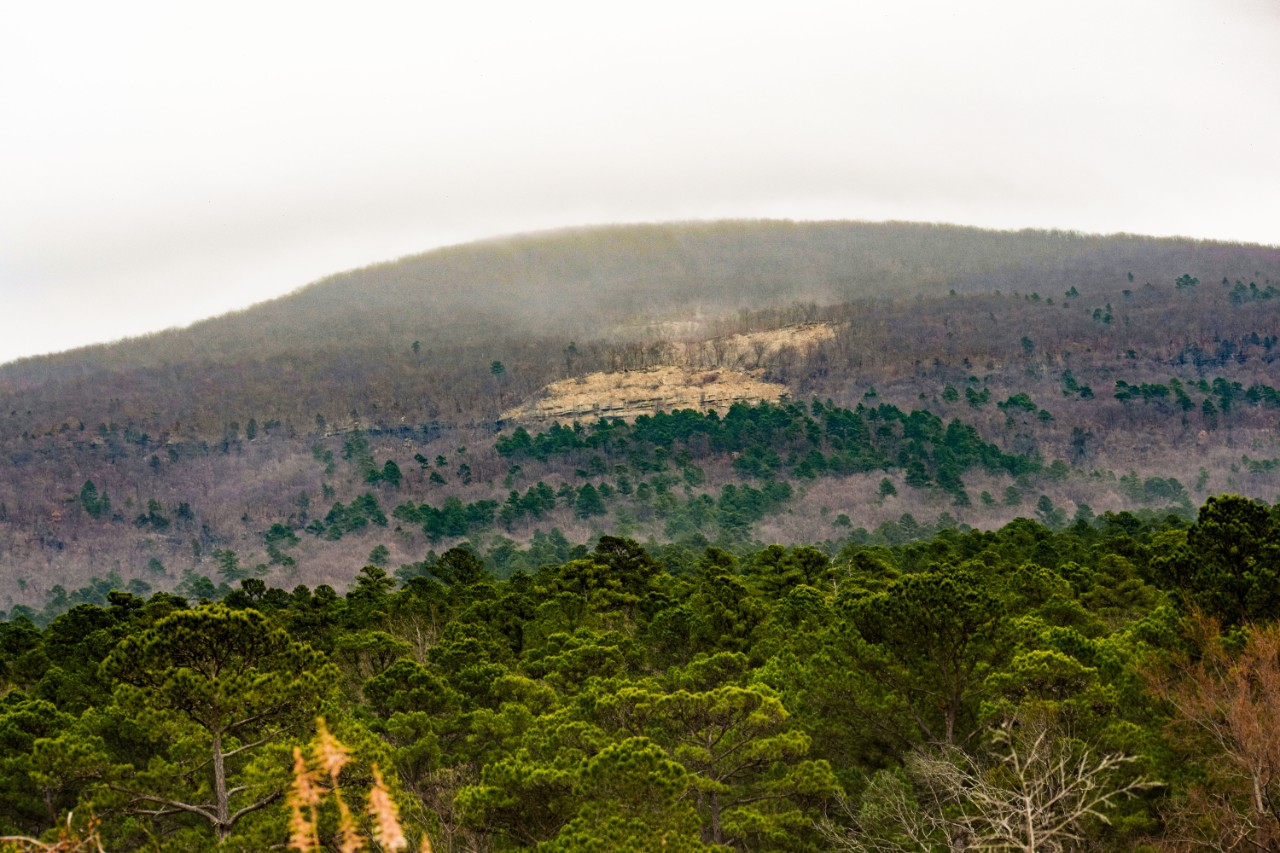
The Acoustic Anomaly Mystery
Recently, the OGS Seismic Team noticed an unusual acoustic pattern recorded by the seismic network. Read about "The Anomaly" on the Field Blog.

NEW – Oklahoma Geoscience/Natural Resources Web Application
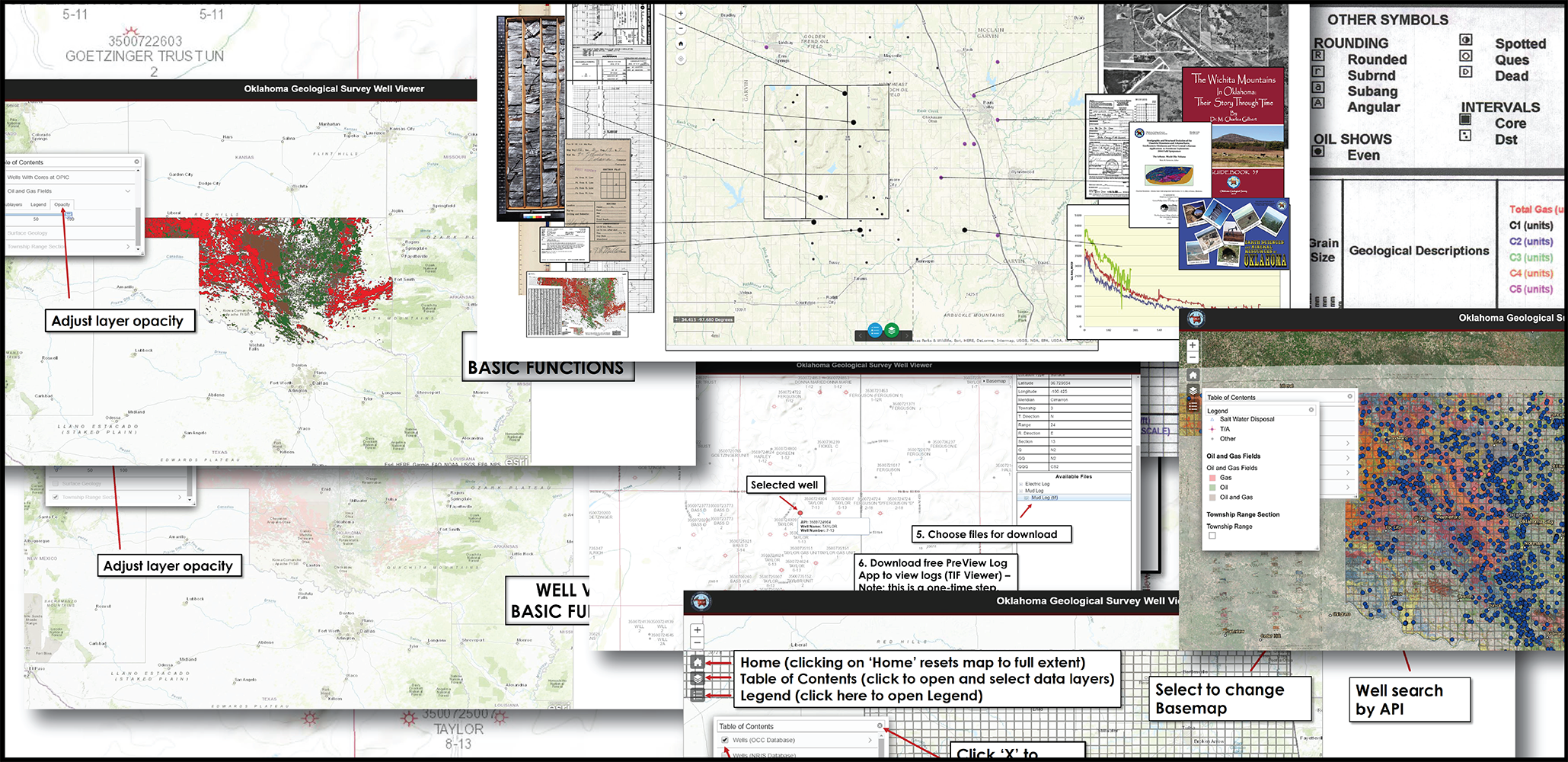
The Oklahoma Geological Survey (OGS) has initiated an effort to develop a comprehensive database of Oklahoma’s geoscience and natural resource data that will be free and accessible to the public via a spatially driven, map-based web application. While presently in its beta release, contents of the database will eventually include digitally preserved images of OGS core and data holdings, publications, and research that will be synthesized with a master record of georeferenced Oklahoma oil and gas wells and associated production values. As stakeholders of Oklahoma’s natural resources, citizens and energy industry professionals alike will finally have a single online source to access a wealth of information relating to the state’s natural resources--including: oil and gas production, core and sample data, geological publications, aerial photography, and more. While this initial effort is focused on oil and gas, future iterations of the application will provide access to non-energy related data, such as hydrogeology, geohazards and the environment.
In addition to in-house collection data, OGS hopes to benefit from partnerships with the Oklahoma Corporation Commission, the Oklahoma Tax Commission and other state agencies to serve as the comprehensive online source for the state’s natural resource data.
This collaborative effort will have a positive impact on the state by facilitating the dissemination of information to industry participants, the scientific community, and citizens, to promote the economic development of state resources through best practices and environmental stewardship.
Please visit the pilot beta version of the OGS web application at the following URL: http://web-pilot.ogs.ou.edu/wells/
For additional information or questions please contact OGS at 405-325-1119 or by email at rdtarver@ou.edu.
NOTE – This is a beta release that is subject to potential downtime due to maintenance and/or operational upgrades. Your feedback is welcomed.
How do you use OGS resources?
OGS hosts technical and core workshop on the STACK Play

Last September, the Oklahoma Geological Survey hosted a workshop focusing on the Sooner Trend Anadarko Basin Canadian and Kingfisher Counties (STACK) Play in Oklahoma. The play was discovered in 2011, and has quickly become one of the hottest resource plays in North America. Despite extensive drilling activity in this play, understanding of the petroleum geology of the area is limited.
The workshop spanned two days, beginning with a day-long technical workshop held at the Moore-Norman Technology Center, which was attended by over 200 people. The following day, two half-day workshops focusing on core were held at the OGS’s Oklahoma Petroleum Information Center (OPIC) in Norman. Each core workshop was attended by around 40 people.
The main objective of the technical workshop was to learn from researchers and operators in the STACK Play, with an emphasis on the Meramec Lime and Woodford Shale. The core workshops presented core from several key wells of the Meramec and Woodford Shale in Blaine, Kingfisher, and Canadian Counties.
David Brown, OGS Associate Director, said that the OGS was uniquely suited for hosting this workshop.
“It’s one of the most important plays in the country right now,” Brown said, “and it happens to be in our backyard.”
To read more about the STACK Play workshop, see the most recent issue of the Oklahoma Geology Notes.
OGS Hosts Seismology Workshop for Teachers
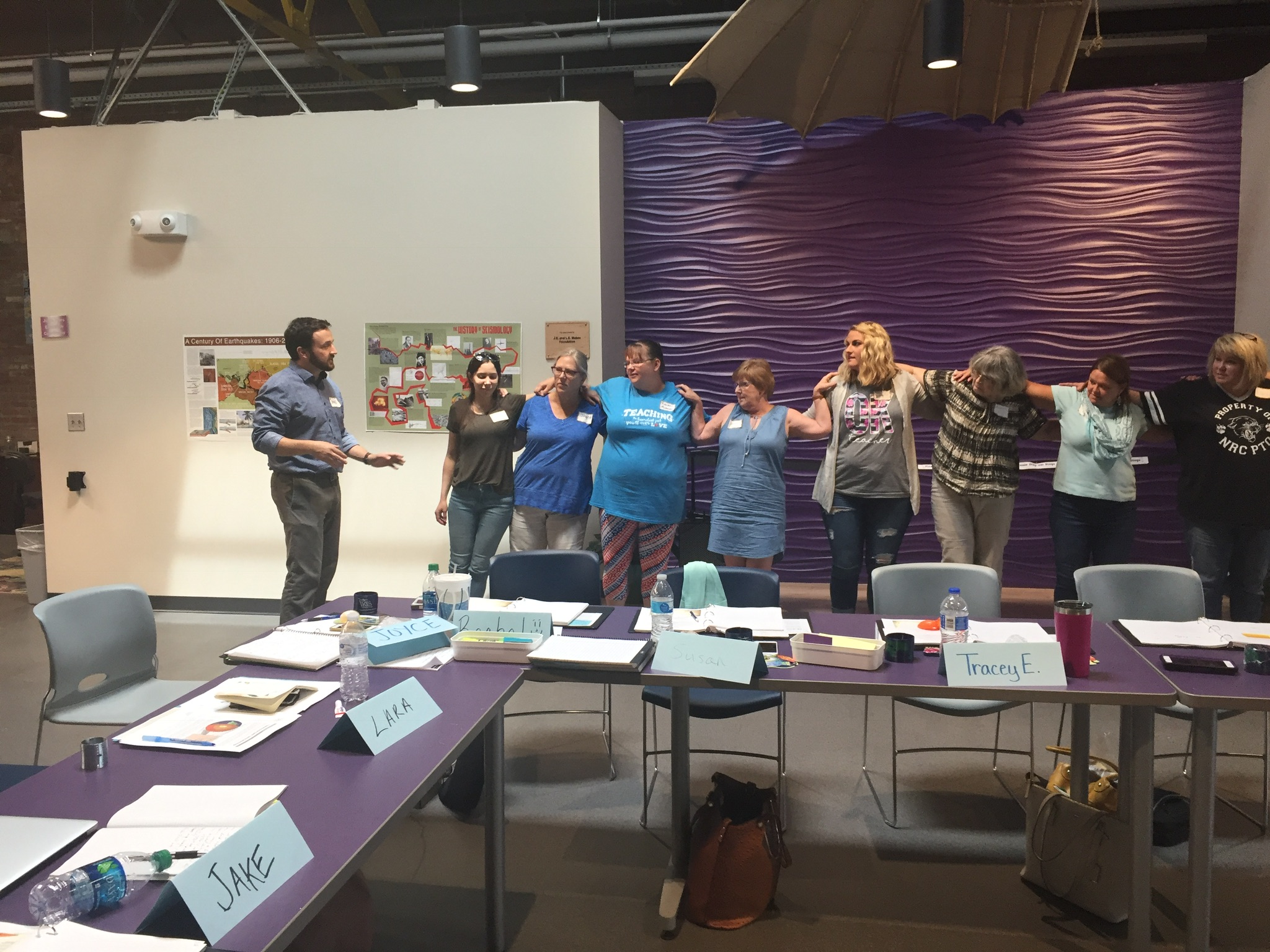
Eleven educators participated in a two-day workshop hosted by the Oklahoma Geological Survey. The educators are part of a project called BLOSSM in Oklahoma. BLOSSM (Bridging Local Outreach & Seismic Signal Monitoring) aims to place a total of 100 personal seismographs (Raspberry Shakes) into educational institutions in Oklahoma, including schools, libraries, and museums. During the first day of the two-day workshop, teachers and librarians received a Raspberry Shake, learned how to install it in their educational facility, and experimented with the type of data it collects. During the second day of the workshop, participants explored introductory seismology and Earth science concepts with the help of State Seismologist, Dr. Jake Walter, his undergraduate student, Sarah Sundberg, and Education & Outreach Coordinator, Dr. Molly Yunker. Participants concluded the workshop with numerous resources including lesson plans, ideas for classroom activities, a working seismograph, seismology posters, and other teaching tools to aid in STEM education next fall and beyond.
USGS Forecast for Damage from natural and Induced Seismicity for 2018
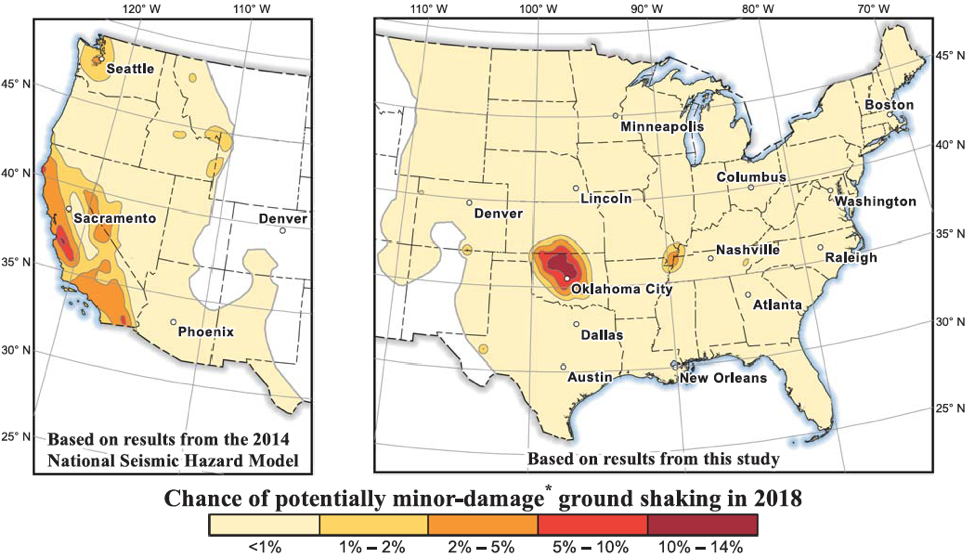
The U.S. Geological Survey has released updated maps identifying potential ground-shaking hazards. The report shows continuing elevated risk of damage in Oklahoma, with some expansion of the area of greatest concern. The expanded area is in part due to slight increases in seismicity in areas that have experienced very few earthquakes previously. The results are significantly dependent upon algorithms used to distinguish main events from aftershocks, which may be different for induced than for natural earthquakes. Earthquake frequency has declined by more than three quarters from the peak in 2015-2016. The Oklahoma Geological Survey, the Oklahoma Corporation Commission, industry and university scientists, are collaborating together to further reduce seismic activity in Oklahoma.
Oklahoma researchers’ studies on Pawnee quake focus of peer-reviewed journal
Seismological Research Letters, an internationally recognized peer-reviewed journal, is dedicating a special issue to scientific studies related to the 5.8 magnitude earthquake that struck near Pawnee last September — the largest recorded seismic event in Oklahoma history.
Dr. Kyle Murray Honored with Environmental Stewardship Award
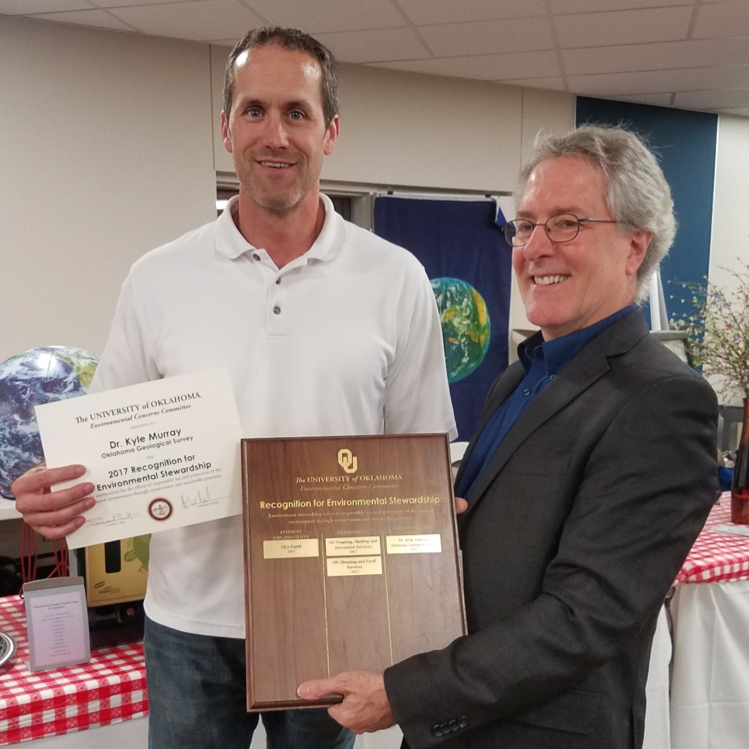
Dr. Kyle Murray Honored with Environmental Stewardship Award
On April 20, 2017, Dr. Kyle E. Murray of the Oklahoma Geological Survey (OGS) was presented a "Recognition for Environmental Stewardship" Award from the University of Oklahoma Environmental Concerns Committee (http://www.ou.edu/admin/ecc/) in appreciation of his efforts in responsible use and protection of the environment through conservation and sustainable practices. The mission of the Environmental Concerns Committee is to "advise the president of the university concerning environmental issues and to promote awareness of energy and other resources conservation, recycling, and personal and environmental well-being and safety."
OGS Field Blog Update
From Bally to Basement: using outcrops to unlock buried rocks
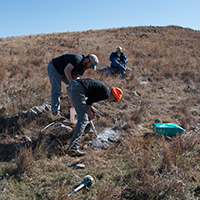
Drilling for Paleomagnetism Samples on Bally Mountain, Oklahoma
Discover the experiences of OGS Geologist Stacey Evans as she investigates fluid flow and paleomagnetism to investigate the Arbuckle Group and the basement rocks in Oklahoma in the latest entry in the Oklahoma Geological Survey's Field Blog.


.png)
